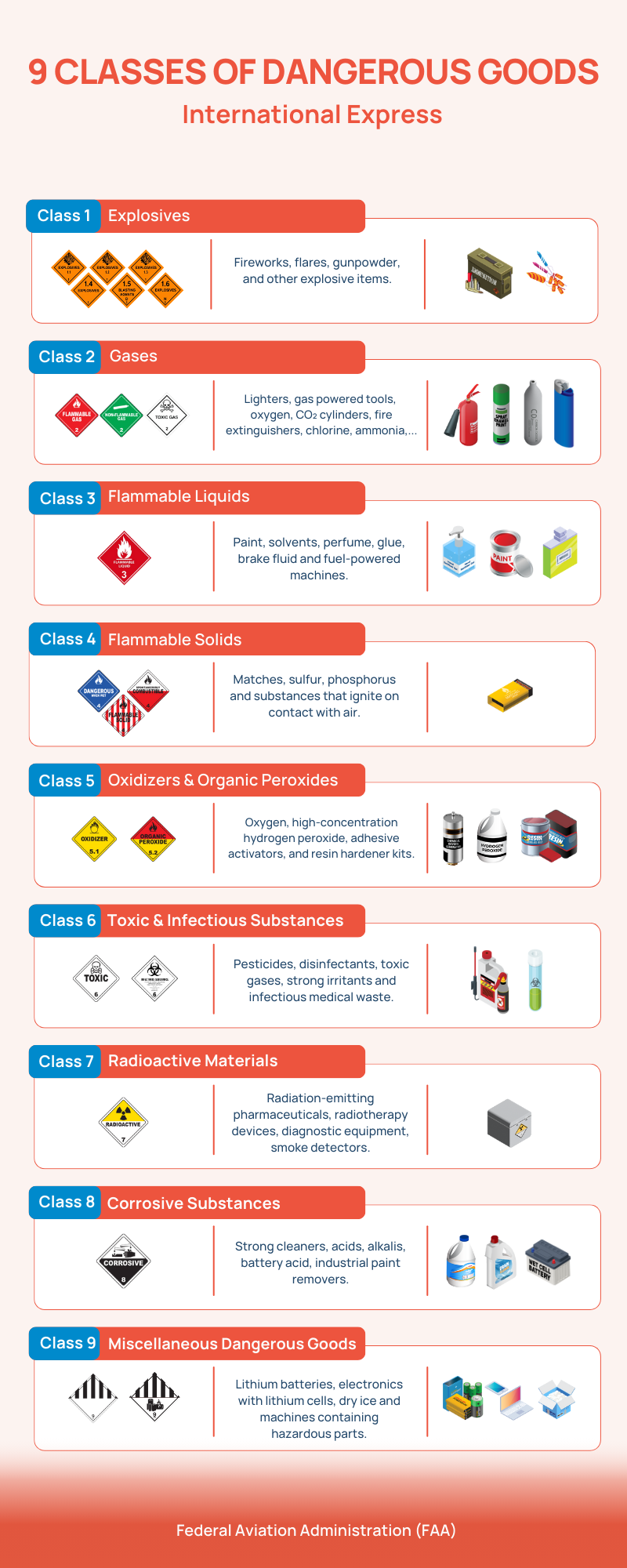PCS is fully equipped and qualified to manage dangerous goods, from packaging to delivery, ensuring strict compliance with international safety regulations. We provide a secure and reliable solution for transporting these specialized shipments, giving you peace of mind every step of the way.
What Are Dangerous Goods?
Dangerous goods are substances or items that pose a significant risk to life, health, property, the environment, or national security during transportation. These materials may be explosive, flammable, toxic, infectious, or corrosive, requiring careful handling, packaging, and shipping to ensure the safety of people, vehicles, and infrastructure involved in the process.
Types of Dangerous Goods
PCS offers international express delivery services for dangerous goods, categorized into clearly defined classes. Our expertise ensures safe and compliant handling of these specialized shipments, including:

Class 1: Explosives
This class includes substances and articles capable of detonation, such as fireworks, flares, and other explosive materials. They are subdivided based on their hazard level:
-
1.1 – Explosives with Mass Explosion Hazard: Substances that can detonate entirely when triggered, causing significant damage. Example: Military-grade explosives.
-
1.2 – Explosives with Projection Hazard: Materials that may explode but not cause a mass detonation. Example: Ammunition.
-
1.3 – Explosives with Fire, Blast, or Projection Hazard: Substances prone to ignition or minor explosions under specific conditions. Example: Fireworks, blasting powder.
-
1.4 – Explosives with Minor Blast Hazard: Items that produce small explosions with limited damage potential if mishandled. Example: Small firecrackers.
-
1.5 – Very Insensitive Explosives with Mass Explosion Hazard: Less reactive but capable of detonation under certain conditions. Example: Certain blasting agents.
-
1.6 – Extremely Insensitive Explosives with No Mass Explosion Hazard: The least hazardous in this class, requiring careful transport nonetheless. Example: Standard ammunition.
Class 2: Gases
This class covers compressed, liquefied, or dissolved gases under pressure, such as gas cylinders and fire extinguishers. Gases are divided into three groups:
-
2.1 – Flammable Gases: Gases that ignite readily and may cause fires or explosions when exposed to heat or sparks. Examples: Aerosol paints, cleaners, deodorants, cooking sprays, lighters, machinery using flammable gases.
-
2.2 – Non-Flammable, Non-Toxic Gases: Gases that don’t burn or pose toxicity risks but may displace oxygen, leading to asphyxiation. Example: Oxygen (non-flammable but enhances combustion risks).
-
2.3 – Toxic Gases: Highly hazardous gases that can cause severe health damage if inhaled. Example: Chlorine (used in water treatment but dangerous upon exposure).
Class 3: Flammable Liquids
This class includes liquids like gasoline, alcohol, acetone, and other highly flammable substances. They require secure packaging to prevent fire risks. Examples:
-
Paints, paint thinners, varnishes, and coatings – common in decoration and surface protection.
-
Extracts (e.g., vanilla extract) and flavorings often containing alcohol.
-
Perfumes and deodorants with volatile, flammable components.
-
Adhesives like industrial or household glues.
-
Alcohol-based hand sanitizers.
-
Machinery or tools powered by flammable liquid fuels (industrial cutters).
Class 4: Flammable Solids and Reactive Substances
These are solids that ignite easily or self-react when exposed to air, such as phosphorus, matches, and sulfur, posing risks if not handled properly.
-
4.1 – Flammable Solids: Materials that catch fire readily upon contact with a heat source. Example: Wood, paper, and organic materials.
-
4.2 – Spontaneously Combustible: Substances that ignite without an external heat source due to chemical reactions with oxygen. Example: Phosphorus, certain metals like sodium.
-
4.3 – Dangerous When Wet: Materials that react violently with water, potentially causing fires or explosions. Example: Sodium, calcium.
Class 5: Oxidizing Substances and Organic Peroxides
This class includes substances that enhance combustion, such as fertilizers, bleaches, and organic peroxides, which can ignite or explode when mixed with flammable materials.
-
5.1 – Oxidizers: Non-flammable substances that intensify the burning of other materials. Example: Oxygen generators (used in medical or industrial settings), high-concentration hydrogen peroxide.
-
5.2 – Organic Peroxides: Peroxide-containing substances prone to explosion or fire under heat or impact. Examples: Adhesive activators, curing agents, and resin kits.
Class 6: Toxic and Infectious Substances
These materials can poison or infect humans, potentially causing death or severe harm if inhaled, ingested, or contacted, requiring specialized packaging and storage.
-
6.1 – Toxic Substances: Substances causing severe poisoning upon exposure. Example: Pesticides, toxic industrial chemicals.
-
6.2 – Infectious Substances: Materials containing pathogens that can spread disease to humans or animals. Example: Regulated medical waste, bacteria, viruses.
Class 7: Radioactive Materials
Radioactive substances pose serious risks to health and the environment, necessitating strict safety protocols during transport and storage.
-
Radiopharmaceuticals: Radioactive drugs used in medical diagnostics or treatments (e.g., cancer therapy).
-
Radioactive Sources: Devices containing radioactive materials, such as smoke detectors or medical equipment, emitting radiation if mishandled.
Class 8: Corrosives
Substances like acids and rust removers can damage transport vehicles, objects, or living tissue upon contact. Examples:
-
Strong cleaners (e.g., chlorine for pools) and corrosive industrial chemicals.
-
Acids (e.g., sulfuric acid, hydrochloric acid) and strong alkalis (e.g., potassium hydroxide, sodium hydroxide).
-
Wet batteries and battery acids that corrode metal.
-
Paint strippers that erode surfaces if misused.
Class 9: Miscellaneous Dangerous Goods
This class encompasses hazardous substances and articles not covered by other classes but still posing risks during transport. Examples:
-
Lithium Batteries: Found in phones, laptops, cameras, and electronics, these can ignite or explode if improperly shipped.
-
Electronics with Lithium Batteries: Devices like cargo trackers require careful handling.
-
Dry Ice: Solid carbon dioxide used for cooling food or pharmaceuticals, posing asphyxiation risks in confined spaces.
-
Machinery with Hazardous Components: Equipment containing compressed gas cylinders or safety parts needing cautious transport.
Safe Packaging and Labeling for Dangerous Goods
Packaging and storing dangerous goods require strict adherence to national and international safety standards. Containers and packaging materials must be carefully selected to suit each type of dangerous goods. Additionally, all hazardous shipments must be clearly labeled with appropriate markings, including:
-
Hazard Symbols: Such as flames (flammable), corrosive icons, toxic warnings, and other danger indicators.
-
UN Number: Each dangerous goods type is assigned a unique United Nations (UN) number for easy identification and classification.
Are you wondering about shipping dangerous international goods or need guidance on packaging and regulations? Contact PCS anytime – our dedicated experts are here to make your journey smooth and secure!
PCS: Your Partner in Safe, Swift, and Trusted Dangerous Goods Delivery.


